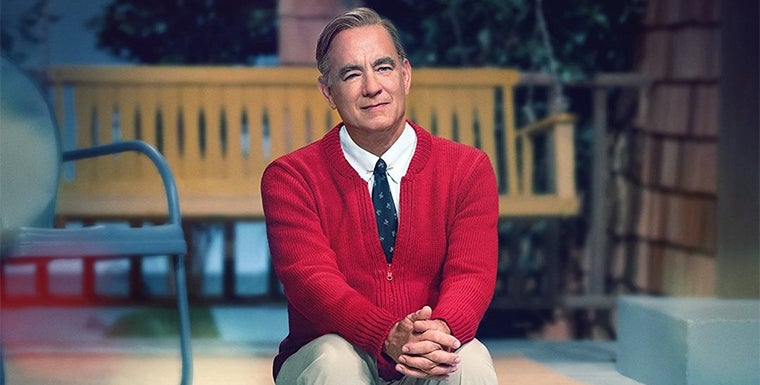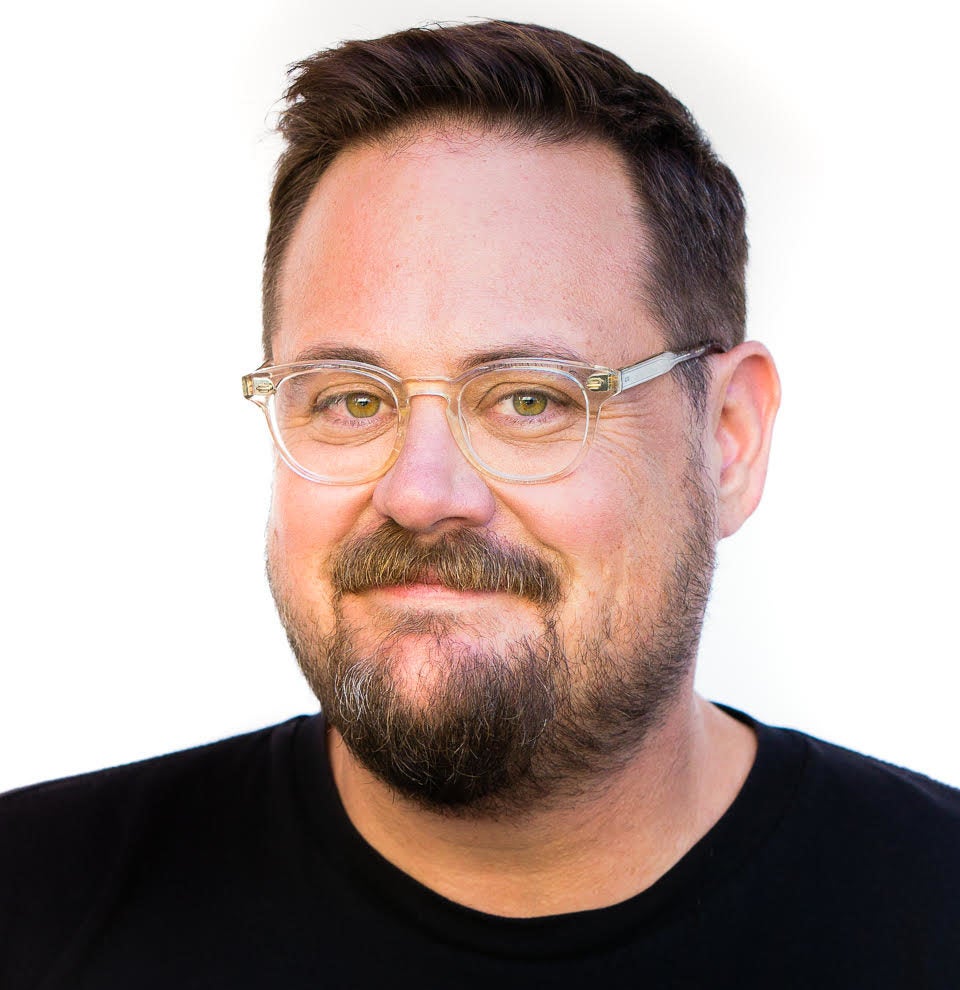
Writing Mister Rogers

Ten years ago, Noah Harpster was a “massively overwhelmed” father of a newborn and an 18-month-old girl. One particularly stressful day, in what he calls “a moment of desperation,” he sat his daughter in front of the television and put on an old episode of “Mister Rogers’ Neighborhood.”
A few minutes later, he recalled, “I looked over at her. She was looking at the screen and listening to him in this profound way. Then she started doing calisthenics with him.”
Amazed and delighted, the UC Santa Barbara alumnus called his writing partner, Micah Fitzerman-Blue. “Mr. Rogers is a warlock!” he exclaimed. “We have to write about him!”
Thus began a decade-long journey that culminated in the November release of “A Beautiful Day in the Neighborhood,” in which the beloved children’s entertainer and moral beacon is portrayed by Tom Hanks.
Co-screenwriter and an executive producer of the film, as well as a member of the cast, Harpster, who graduated with a BFA in acting in 1998, will answer questions after a screening of the film at 2 p.m. Saturday, Jan. 11 in the Pollock Theater. Tickets are free, but reservations are recommended to guarantee a seat; they can be made after 11 a.m. today, Jan. 2, at https://www.carseywolf.ucsb.edu/pollock-events/script-to-screen-a-beautiful-day-in-the-neighborhood/.
As Harpster will no doubt discuss, the project came perilously close to falling apart several times over the 10 years. The screenwriters’ first idea — a traditional biographical picture — quickly proved unworkable. “He was unwaveringly awesome for 74 years,” Harpster discovered. “There’s no character arc!
“But being entranced by Fred and his message, we started looking at people around him,” Harpster continued. “We learned there were a lot of people who had their lives changed by Fred — hundreds of people.”
Realizing the way into Rogers’ story was through his relationship with one such person, the writers came up with a first draft of a screenplay, which “we had no right to do,” Harpster admitted. “We didn’t have any rights to Mr. Rogers’ name, or to the music, or anything.”
When they finally approached Bill Isler, president and CEO of the Fred Rogers Company, he gave them a firm no. But the writers stayed in touch, and little by little wore Isler down.
“A year and a half later, he introduced us to (Fred’s widow) Joanne,” Harpster recalled. “We spent hours listening to her stories and answering questions. She only had one demand of us if we were going to do this, and that was that we not treat her husband as a saint. Her attitude was, if he were portrayed as a saint, it would negate the hard work that he did, and deny the reality that other people could do it.”
Their next stop was the archives. “We put on white gloves and went through all of these letters and printed-out e-mails — boxes and boxes of correspondence Fred had with dozens, if not hundreds, of people.” They were particularly drawn to his correspondence with Tom Junod, who profiled Rogers for Esquire magazine.
“There were 250 e-mails, back and forth, printed out, along with handwritten letters,” Harpster said. “We realized this was a friendship, and a ministering, that went on for five years — right up until Fred’s death in 2003. That’s when we realized that Tom’s story would be the backbone of the film.”
That said, the final screenplay often strayed from Junod’s actual story. “A lot of it is based on Tom’s life, and a lot of it is about things we found in the archives about other people. A lot of it is based on our own lives. During the course of this, my father was diagnosed with cancer and passed away. So I was writing about that as well.”
Harpster’s own story does have an arc, which takes its first bend his sophomore year at Salinas High School. When he failed to make the baseball team (the coach’s son took his position), “a friend suggested I audition for a play. I said, ‘No way in hell. But I’ll run the light board.’ So I did that for ‘The Odd Couple.’
“At one point, the guy playing the character of Speed was suspended from school for pulling a knife on a teacher. The drama teacher, Mr. Bradley, said, ‘You’re going on tomorrow.’” Harpster agreed, and his reluctance vanished when he started getting laughs.
As a senior, he visited a friend at UC Santa Barbara and instantly decided it was the school for him. He did not get cast in many school productions, but those rejections provided the catalyst he needed.
“One teacher, James Donlon, said to me, ‘If you’re not getting cast, do your own f---ing thing,’” Harpster recalled. “That was hugely motivating to me. Every creative success I have ever had sprung from that moment.”
After graduation, he founded his own company, “Woven,” which produced evenings of short plays and comedy sketches. “In a way, it was our grad school,” he said. Four years later, a commercial agent saw him in a Santa Barbara City College production and signed him, which brought him to Los Angeles.
Fitzerman-Blue became his writing partner a few years later, after they were set up on what Harpster calls “a creative blind date.” Together, they went to work on what was supposed to be a small web series, “Transparent.” They ended up spending four years on the Emmy-winning Amazon show as writers and producers.
After that gig ended, they focused again on the Mister Rogers script, which became a hot property after it was put on a “blacklist” of best unproduced screenplays. When director Marielle Heller came on board, she asked who they were thinking about as the lead.
“We said ‘We’d like Tom Hanks, but let’s get realistic,’” Harpster said. “But she convinced him to do it. He’s a delightful, kind person — an amazing artist and human being.”
It takes one, perhaps, to portray one.



